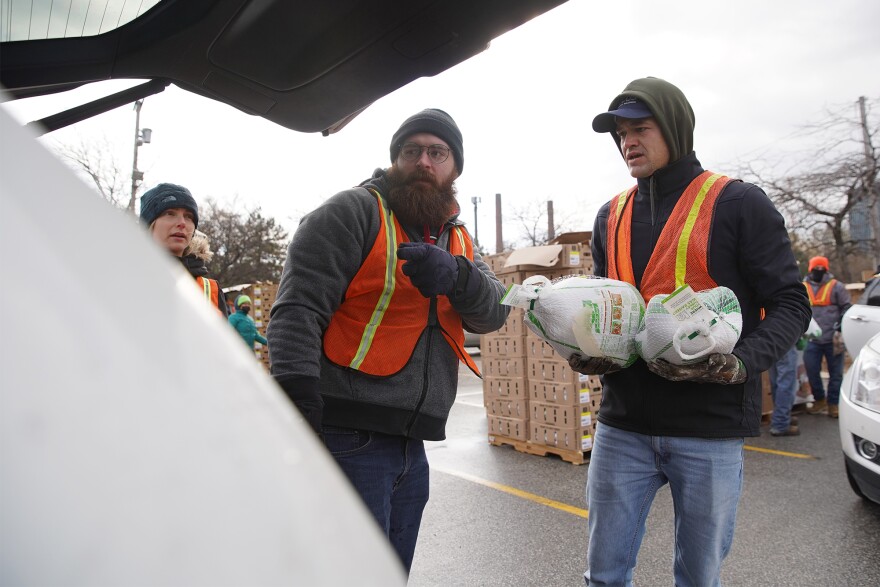Volunteers swayed to the music as they loaded up cars with boxes of produce and bags of potatoes at the City of Cleveland Municipal Lot recently.
The Greater Cleveland Food Bank handed out boxes of food and turkeys to about 4,000 families that day.
Tamia and Tammy Macon were there to pick up food for four families that will be coming to their home for Thanksgiving dinner.
While volunteers arranged the boxes in the car, the women chatted about what dishes they are all making — macaroni and sweet potatoes.
“I’m glad we didn’t have to buy a turkey,” Tamia Macon said.
She was surprised by how expensive turkeys are this year.
Nationally, turkey prices reached a record high of $1.72 per pound. For a 15 pound turkey, that’s $25.80.
Some of the more than 240,000 food-insecure people in Cuyahoga County are relying on food banks to help with turkeys and other staples, especially as inflation has increased the cost of Thanksgiving dinner this year.
Prices for a Thanksgiving bird though were sky-high even for the area food banks.
The Cleveland food bank and the Akron-Canton Regional Foodbank both bought their turkeys back in the spring to guarantee low prices and enough birds, but even back then they faced the same markups as consumers.
“We got about 19,000 turkeys this year,” said Karen Pozna, director of communications for the Greater Cleveland Food Bank. “We paid over $100,000 more this year for turkeys than we did last year,” Ponza said.
In September, the Cleveland food bank found out they would be getting two fewer trucks of turkeys this year. The vendors said the avian flu had limited the supply, Pozna said.
Since they were short the couple hundred birds they had planned for, they gave out chicken instead to some seniors and individuals, she said.
The food bank served 12% more people in September than they have in the last few pandemic years, she said. Families are still struggling from setbacks they experienced during the last two-and-a-half years, but now the things that helped feed them, like child tax credit and free school meals are gone. Inflation makes those burdens worse, she said.
People are guaranteed food when they register with the food bank, but some showed up hours early at the recent event just to be sure they’d get their food, Pozna said.
“People are worried that somehow we're going to run out,” she said. “Once they [receive their food], you can see the relief in lots of people's faces.”
In Lorain County, a group of school kids volunteered last week at the Second Harvest Food Bank of North Central Ohio. They packed about 2,000 boxes on the assembly line with food that will go to county residents.
Susan Bartosch, vice president of external affairs at Second Harvest, said food donations from large chains like Walmart and Giant Eagle dropped by 30% this year.
The food bank asked for help from the county commissioners, who gave them $82,000 from their American Rescue Plan Act (ARPA) funds.
“They thought this was a great use of those funds, so we’re grateful,” she said.
Even with the money, issues piled up. A nationwide shortage of protein made it hard for the bank to purchase meat and several holiday food items were difficult to find, Bartosch said.
“If we're looking [for meat], there's a whole bunch of other even grocery stores looking. We're in competition with other food banks, grocers, everybody, to buy it,” she said. “It's like there's only so much to go around for all of us.”
Supply chain issues that started during the pandemic haven’t improved, said Bartosch.
“[Vendors tell us] you'll have it in four weeks. Well, then three months later you get it,” she said.
For all the hassle, some wonder is it worth it to get a turkey?
One of the Cleveland distribution’s volunteers Charles Gardner said “yes.”
“We’re going to drop it in the fryer,” Gardner said. “Sizzle it baby, you know what I mean?”

















